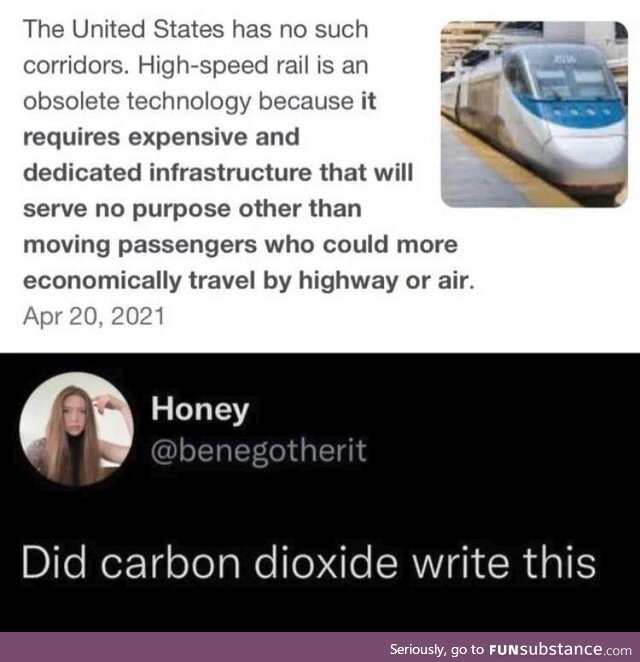Featured Posts

I wish I had a fort

The powerof positive thinking

NASA

Pray for Australia

Take care of each other

She has emerged

My soul feels so much better

I just ordered one. #Just2019HispanicThings

He really wanted his photo at the Halloween party, but was super scared of the spiders

The Only Thing More Contagious Than COVID19 Might Be This Fox's Smile
About
FAQ
Contact
Rules
Terms
Privacy
Feedback
Keyboard Shortcuts:
Previous Post · Next Post · + CTRL Skip Post
Previous Post · Next Post · + CTRL Skip Post
© 2025 FunSubstance · funny and entertaining pictures, memes, gifs & videos.



Rail has its “pleasure seekers,” but by the numbers when it comes to travel, people tend to use rail and light rail for things like daily errands and work. In many places like states with train routes to NYC or LA or SF, a person might take a 2-3 hour train ride or have a 2-4 hour commute everyday. Because air travel tends to be for direct business requiring travel, or occasional pleasure, and trips via air tend to be more expensive trips total (even though long distance train tickets often match or exceed airfare, the nature and particulars of the sorts of trips..
Hands down loading trucks is slower than loading trains for bulk pack. When it comes to distributing smaller loads such as to businesses and consumers like retail goods- trucks win in almost every way. Because trucks are cheaper than trains and roads work better than rail for “hops,” you can have 100 trucks delivering, 60 for target and Walmart and “Dave’s home town business” and then 40 for home delivery for example. Whatever the number of stops, it is at least 100, each individual gets their goods faster and the time between the first and last stop would be much shorter than a train snaking 100+ stops including residential. (Not to mention the disruption to how towns and cities would have to be designed for rail service to these locations…) we can go up the supply chain from end user to distribution center and outside of HUGE bulk goods like raw materials for construction or factory use, it’s going…
Humans are perhaps like a bio weapon or a cancer as we are now in terms of the environment I think. All life natural in the world is mutation, adaptation, so we could change, but will we change before we go to far, ir before we must change just to survive? I suppose that’s less a concern for those alive at this moment than to “enjoy the ride while it’s there.”
That said- the earth doesn’t actually need us to help it though. It just needs us to not destroy it. Or I guess technically, we need us to not destroy our ability to live here, and other life forms need us to not destroy their ability to live here, but it’s unlikely anything we could do could make it so that NO life could exist here since there are all sorts of creatures that thrive in all temperatures and without water or sun, in radiation and even in the “clean rooms” used to sterilize space equipment and such. So I guess…. I’d still say in that regard we are more like a cancer. We could be benign and not cause any direct harm but just exist with all the other cells that make the whole, or we could be malignant and make it so ourselves or other cells can’t survive it potentially actually destroy the body so only the corpse supports life?